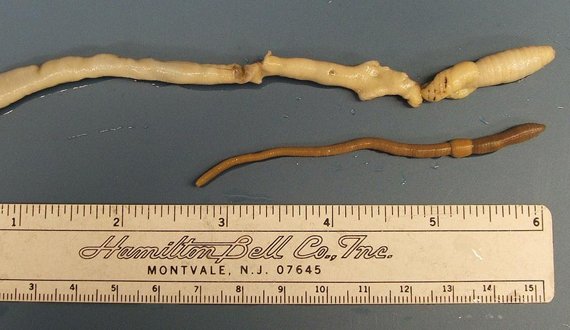
Now, you might be wondering why this matters. Well, these interactions are essential for soil health, nutrient cycling, and the overall balance of the ecosystem. Just like how we rely on each other for support and friendship, every organism, no matter how small, plays a role in this complex web of life. So, let’s dig deeper into how the Giant Palouse Earthworm interacts with its microscopic neighbors and why those connections are crucial for maintaining a thriving environment.
What is the Giant Palouse Earthworm?
The Giant Palouse Earthworm is more than just a simple invertebrate; it stands out because of its impressive size. Typically, it can grow up to three feet long! This earthworm thrives in the Palouse region, known for its rich, loamy soil. But what makes it truly unique is its ability to produce a gooey, white secretion that helps it survive in its native environment.
This worm spends much of its life underground, where it creates burrows. These tunnels not only help the worm move through the soil but also facilitate air and water flow, making the soil healthier for plant roots. While it may seem like a solitary creature, the Giant Palouse Earthworm is an integral member of a bustling community of microfauna.
Interactions with Soil Microbes
Soil is teeming with microbes—bacteria and fungi that might be tiny but play a colossal role in nutrient cycling. The Giant Palouse Earthworm interacts with these microbes in a few significant ways. For starters, when it burrows through the soil, it disturbs the ground, which allows oxygen to enter and stimulates microbial activity.
Furthermore, the worm’s secretions provide a food source for these microorganisms. The organic matter in its excretions helps microbes flourish, creating a balanced ecosystem. This relationship is a perfect example of mutualism, where both the worm and the microbes benefit. The worms get healthier soil, while microbes gain nutrients to thrive.
Role in Nutrient Cycling
Nutrient cycling is how minerals and nutrients flow through the ecosystem. The Giant Palouse Earthworm plays a crucial role in this cycle. As it breaks down organic matter like dead leaves and plants, it releases essential nutrients back into the soil. Think of it as nature’s composting service!
When worms decompose organic material, they convert it into forms that plants can easily absorb, such as nitrogen and phosphorus. These nutrients are crucial for plant growth and help increase biodiversity. More plants mean more food for herbivores, which then supports carnivores. It’s a beautiful cycle, really, and it all starts with our earthworm friend.
Interactions with Other Invertebrates
The soil is home to many other invertebrates, including nematodes, springtails, and mites. The Giant Palouse Earthworm interacts with these critters in various ways. For example, as the earthworm aerates the soil, it creates a healthier environment for these smaller invertebrates to thrive.
Moreover, the organic material the worm breaks down is attractive to other invertebrates. Nematodes, for instance, can feed on the bacterial populations that bloom in the wake of the earthworm’s activities. In this dance of life, every participant has its role, and the Giant Palouse Earthworm is a key player, helping maintain the balance among soil-dwelling species.
Impact on Soil Structure
The structure of the soil affects water retention and the ability of plants to establish roots. When the Giant Palouse Earthworm creates its tunnels, it helps to improve the soil structure, making it more porous. This means better drainage during heavy rains and increased moisture retention during dry spells.
This improvement is essential for overall soil health. Healthier soil produces healthier plants, which in turn supports a host of other organisms. It’s like the earthworm is working behind the scenes, ensuring everything in the ecosystem is working together smoothly.
Threats to the Giant Palouse Earthworm
Despite its importance, the Giant Palouse Earthworm faces several threats. Urban development and agricultural practices can disrupt its habitat, leading to a decline in its population. When these earthworms decrease, it creates a ripple effect throughout the ecosystem.
Reduced earthworm populations mean less aeration of the soil, less nutrient cycling, and fewer interactions with other microfauna. This decline can lead to poorer soil quality and less biodiversity. Protecting the Giant Palouse Earthworm isn’t just about saving one species; it’s about safeguarding the entire ecosystem.
Conservation Efforts and the Future
Conservation efforts are vital to protect the Giant Palouse Earthworm and its habitat. Organizations dedicated to preserving the Palouse region are working on various initiatives, from habitat restoration to public awareness campaigns. They aim to educate people about the importance of this unique earthworm and its role in the ecosystem.
This proactive approach is essential; by promoting sustainable agricultural practices and ensuring that developments consider the local ecology, we can help safeguard the future of the Giant Palouse Earthworm. Every little action counts, and it’s up to us to protect these vital links in the chain of life.
In summary, the Giant Palouse Earthworm is a remarkable creature that plays a significant role in its ecosystem, interacting with a variety of microfauna to maintain soil health and nutrient cycling. Understanding these interactions not only fosters appreciation for this unique worm but also highlights the importance of conservation efforts to protect its habitat. So, the next time you think about this giant worm, remember all the unseen connections it creates below the surface, keeping our ecosystem balanced and thriving.
